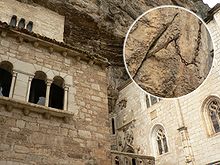Durendal


Durendal or Durandal (most likely from the French durer,[citation needed] "to endure") is the sword of Charlemagne's paladin Roland in the genre of literature Matter of France.
Sword
The sword has been given various provenances. Several of the works of the Matter of France agree that it was forged by Wayland the Smith, who is commonly cited as a maker of romantic weapons.[1]
According to the Song of Roland, the sword is brought by an angel to Charlemagne, who gives it to Roland.[2] According to Ludovico Ariosto's Orlando Furioso it once belonged to Hector of Troy, and was given to Roland by Malagigi (Maugris).
In The Song of Roland, the sword is said to contain within its golden hilt one tooth of Saint Peter, blood of Saint Basil, hair of Saint Denis, and a piece of the raiment of the Blessed Virgin Mary, and to be the sharpest sword in all existence.[3] In the poem, Roland uses the sword to hold off a hundred-thousand-strong Muslim army long enough for Charlemagne's army to retreat into France.[4]
Roland attempted to destroy the sword to prevent it from being captured by the attacking Saracens, and created Roland's Breach in the Pyrenees in the process.[5] But Durendal proved indestructible, so he hid it beneath his body along with the oliphant, the horn used to alert Charlemagne.[6]
Local folklore claims Durendal still exists, embedded in a cliff wall in Rocamadour, Midi-Pyrénées. In the twelfth century, the monks of Rocamadour claimed that Roland threw the sword rather than hiding it beneath himself. However, the local tourist office now calls the sword a replica of Durendal.[7]
Footnotes
References
- Auty, Robert (1980). Traditions of Heroic and Epic Poetry. London: Modern Humanities Research Association. ISBN 0-900547-72-3.
- Brault, Gerard J. (1996). The Song of Roland: An Analytical Introduction and Commentary. University Park: Pennsylvania State Univ. ISBN 0-271-02455-0.
- Caro, Ina (1996). The Road From the Past: Traveling Through History in France. San Diego: Harcourt Brace & Co. ISBN 0-15-600363-5.
- Cox, George William (1871). Popular Romances of the Middle Ages. London: Longmans, Green, and Co.
- Numismatic and Antiquarian Society of Philadelphia (1902). Proceedings of the Numismatic and Antiquarian Society of Philadelphia. Philadelphia: Numismatic and Antiquarian Society of Philadelphia.
- Walsh, William Shepard (1914). Heroes and Heroines of Fiction. London: J. B. Lippincott Co.

